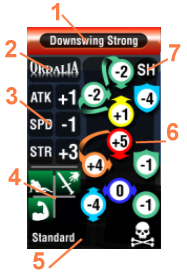ORDALIA GAME SYSTEM MANUAL
Ordalia Maneuver Cards
The core of Ordalia Game System are, of course, the playing cards. Among the different types of cards, the Maneuver cards represent the actions and moves that a Character can choose during a combat round. Maneuver cards are grouped in different Maneuver Types:
- Vertical Attack (V): these are vertical swinging attacks, usually executed with a downward trajectory aimed at the upper side of opponent's figure. These are the most powerful attacks, but also the slower ones and the most vulnerable to low attacks (SL and LL).
- Strike High (SH): these are horizontal or diagonal swinging attacks aimed at the head and the upper side of the target. They deal less powerful than the Vertical attacks, but are safer and faster.
- Strike Low (SL): these attacks are horizontal or diagonal swinging blows aimed to the lower side of the opponent. They are otherwise quite similar in characteristics to the Strike High attacks.
- Lunge High (LH): this type of maneuver consists in fast, deadly thrusts aimed at the upper side of the body and the head. They lack some of the power of the Strike High attacks, but are faster and in many cases safer.
- Lunge Low (LL): these attacks work the same as the Lunge High type, but are aimed at the lower side of the target's body.
- Defense High (DH): these defensive Maneuvers consists in blocks, parries and movements trying to ward off attacks aimed at the upper side of Character's body (i.e. V, SH and LH attacks). They are less effective, or even dangerous, against low attacks.
- Defense Low (DL): with this type of Maneuvers the Character tries to parry, block or evade attacks aimed at the lower side of his or her body. Like the DH maneuvers, they are ineffective against attacks aimed on the opposite side of the body.
- Movement-Side (MS): this type of Maneuvers consists of rapid movements
on the side of the engagement line, to dodge and evade incoming blows. They are
most effective against Vertical and Lunging attacks (V, LH and LL), while they
are vulnerable to Strike attacks. They also are less safer than DH and DL defenses,
but can obtain much better tactical advantages.
Fast Characters can enjoy the benefit of using their SPD value instead of their DEF value, if higher, using this class of Maneuvers. - Movement-Line (ML): with this type of defensive Maneuvers the Character moves fast along the line of engagement, stepping closer and moving away from the enemy as needed, to get away from incoming attacks. These defenses are most effective against swinging attacks like V, SH and SL. They share the same general benefits and drawbacks of MS maneuvers, with the exception of being vulnerable to LH and LL attacks instead.
- Special (S): this class includes any
action not specifically defined as an offensive or defensive combat action,
like staying on guard, casting spells, concentrating and so on.
The Maneuvers in this class can have the most various effects, and differ
greatly from card to card in strengths and vulnerabilities.
In combat, Special Maneuver cards are stacked in the defensive deck.
Each Maneuver class has its most effective use in the game. Attacks are obviously
used to hit the opponent, but can also be effective at defending from similar attacks.
In this case the Speed of the attack can be very important, because a much faster
attack can hit the opponent interrupting his or her attack. In other cases, similar
attacks simply neutralize each other or both hit the target, as determined by
the game system.
Defenses, on the other hand, are very unlikely to score a hit on the opponent
but are more effective to avoid blows, and safer even when matched against the
opposite attacks. They are most effective at obtaining tactical advantages, to
gain free actions, disengage from combat or standing up if fallen down.
Last but not least, some Defenses are useful to move at the perfect engagement
distance for the main weapon the Character is using, when pitted against the attacks
they are more effective against.


|
|